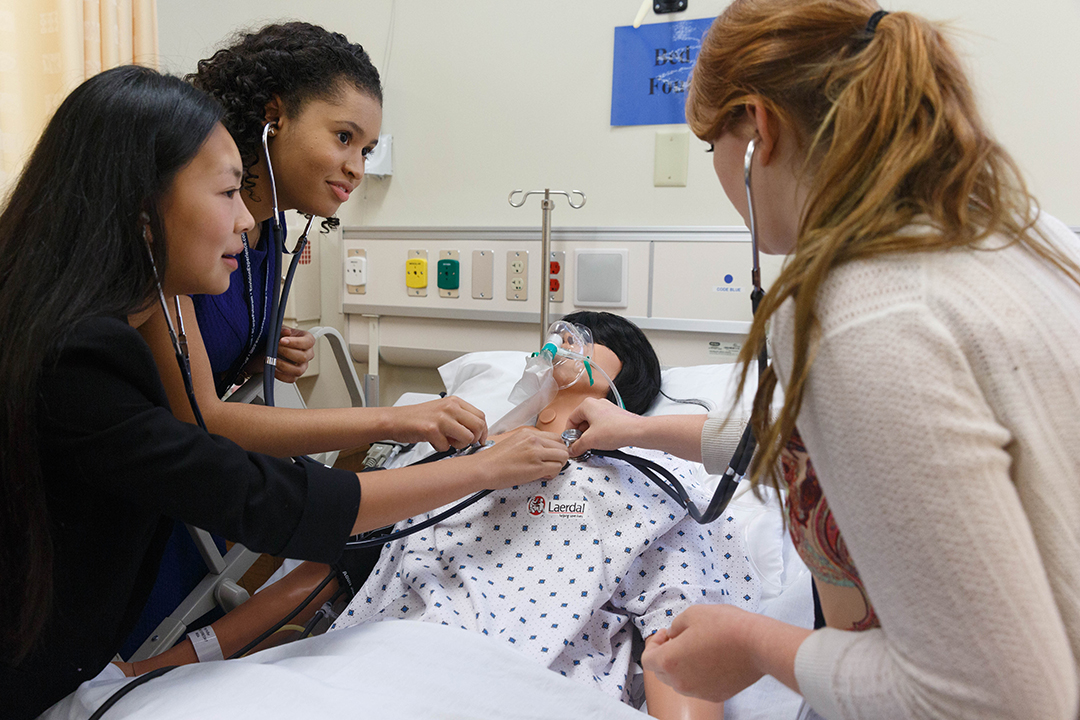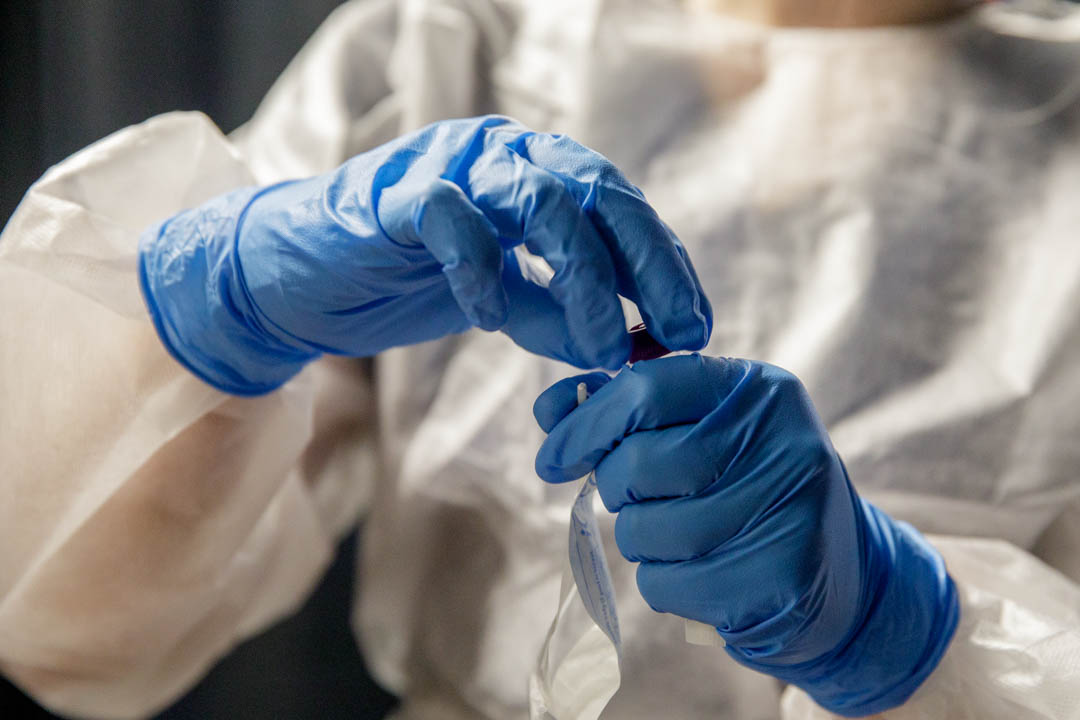By Kristen Mitchell
Two new studies from the George Washington University School of Nursing examine the evolving restrictions American hospitals have put in place to protect vulnerable infants and health care workers from contracting COVID-19.
Together with a team of scientists, Ashley Darcy-Mahoney, a professor and researcher focused on infant health and developmental outcomes in high-risk infants, published two studies on COVID-19 and its impact on infant care. The first study, published in August, surveyed parental presence restrictions implemented by neonatal intensive care units (NICUs) and found wide-ranging policy differences. The second study, published this month, was a cross-sectional survey of U.S. NICUs during the first wave of the COVID-19 outbreak.
Among a large cohort of NICU infants, the prevalence of infants under investigation or with confirmed neonatal COVID-19 disease was low—prevalence rising from one patient to 15 patients—across the four survey rounds. Despite the low burden of SARS-CoV-2, most responding NICUs have defined policies regarding where to care for infants born to persons under investigation (PUIs), breastfeeding approaches, and hospitals have adopted maternal screening practices. The responses indicate most NICUs have adopted policies weighing toward substantial caution regarding interaction between PUI and COVID-19 positive mothers with their infants, Dr. Darcy-Mahoney said. The most recent survey shows an decrease in isolation of infants from their mothers and an increased number of NICUs allowing direct maternal breastfeeding.
GW Today spoke with Dr. Darcy-Mahoney about the major takeaways from her recent research.
Q: What motivated you to explore how COVID-19 has impacted interactions between parents and their infants in neonatal intensive care units?
A: The ways COVID-19 overwhelmed adult intensive care units (ICUs) was profound, substantial and consequential. The visiting restrictions that were placed on the adult ICUs were done so in an effort to protect health care workers, and there’s no doubt in my mind that the intention was absolutely in the best interest of the people caring on the frontlines and an effort to make everyone as safe as possible, especially in an unknown circumstance.
What ended up happening is that in some of our neonatal and pediatric ICU units, we saw a substantial decrease in parent presence as a result of the restrictions that hospitals put in place. These restrictions were varied; they were done without a lot of evidence because, frankly, we just didn't have any. They were also done differently across the United States, across cities and across hospitals. That said, restrictions also changed over time. Some hospitals were really strict in the beginning and loosened those restrictions as more evidence became available as the pandemic continued.
From a personal perspective, I saw parents and families struggling. It was really hard to watch a mom only be able to come visit her newborn three hours a day without her partner being present because there was a restriction for only one parent to enter the unit..
Q: What additional type of NICU restrictions did hospitals put in place in response to COVID-19?
A: Broadly speaking the restrictions were related to number of people at the bedside and how many hours those parents were there. Almost universally units said no one else is allowed except for parents— which means that there were no grandparents, aunts, uncles, siblings or other family members that often provide substantial support for new parents.
Many units also had substantial restrictions on the time and hours of the day a parent could visit. A few units had extraordinary strict rules around parent presence to mirror the adult ICUs where no one could come visit. Those are fewer and far between as the pandemic went on and as we had evidence that we could do it more safely.
Q: What do your findings tell us about these policies?
A: We surveyed neonatal ICUs and asked to the extent the pandemic led to restrictions in parental presence for sick newborns. Overall we found that 47% of the responding NICUs had imposed new restrictions on parental presence. Most of these NICUs only allowed one parent at the bedside at any given time, and a subset required families to pick a parent to stay during that hospital stay. A handful of hospitals completely restricted parents from the bedside. Additionally, 43% of NICUs reported a reduction in therapy services, for example, occupational health, physical therapy, speech therapy, lactation and/or social work support.
NICU administrators have had to balance the need for parents to be present with their infants and in their infants’ care with the risk of horizontal transmission of COVID-19. However, restrictions in parental presence and a decrease in supportive services may lead to adverse secondary consequences for infants and their families. We did find that the presence of single family NICU rooms, as opposed to open bay units (where it’s a challenge to maintain distance from others), did appear to attenuate these restrictions. The infectious isolation benefit of single family room NICU design might be another way this type of design can promote parental presence for ill newborns.
Q: One of the studies you authored found it’s unlikely that infants would contract COVID-19 from their COVID positive mothers. What do you think hospitals should do differently in light of these findings?
A: Among a very large cohort of NICU units in the United States that we surveyed at four different time points, the prevalence of COVID-19 or infants under investigation were very low. Despite this, many NICUs adopted policies that limit interaction with COVID-positive moms and their newborns.
We saw that the changing and very useful guidelines from the American Academy of Pediatrics (AAP) were implemented rapidly—the uptake of the evidence was more rapid than I’ve ever seen before in my career in the NICU. Initially, we saw the guidelines in the beginning of the pandemic say we may want to separate moms and babies, that it might not be good for babies to directly breastfeed, as we gained more information, we saw that the AAP did an incredible job of looking at that evidence, analyzing it to the best of their abilities, and putting out statements that hospitals and units could then take up and change policies with the newest evidence.
We also saw that the number of infected babies, while still quite small, does rise when community spread is higher. So it's not that the babies aren’t at risk, it’s that they are at lower risk. The short- and long-term impact of clinical practice policies really require consistent and continued investigation. In general, hospitals should continue to evaluate the evidence of changes in community spread. If there is increased community spread, maybe that’s when we have to have more restrictions. But in places where community spread remains low, it doesn't seem particularly useful to not allow parents to be present in their infant’s care.
Q: What are the next steps for this research?
A: Our biggest next steps are to begin to understand how prematurity has been impacted by COVID-19. There’s been some conflicting reports on whether we’ve had lower numbers of preterm babies or we’ve had higher numbers of preterm babies during the pandemic, whether this is related to more stress or less stress. So, we’re trying to understand lots of different things with respect to COVID-19 and preterm babies.
As it relates to parent presence, I think the next step is to understand from a qualitative perspective what is going on in the NICU. Did NICU medical directors, nursing directors and nurse practitioners have a say in some of these unit-wide policies? And if they didn’t, how can we begin to change that? How did parents feel, did they feel comfortable with these restrictions, were they equally concerned about passing on COVID to their own baby, to the staff? Did it increase PTSD, which we know is really high in neonatal ICUs already for families? I think trying to understand the impact of decreasing parental presence in the NICU is something that we will do in the long-term.





